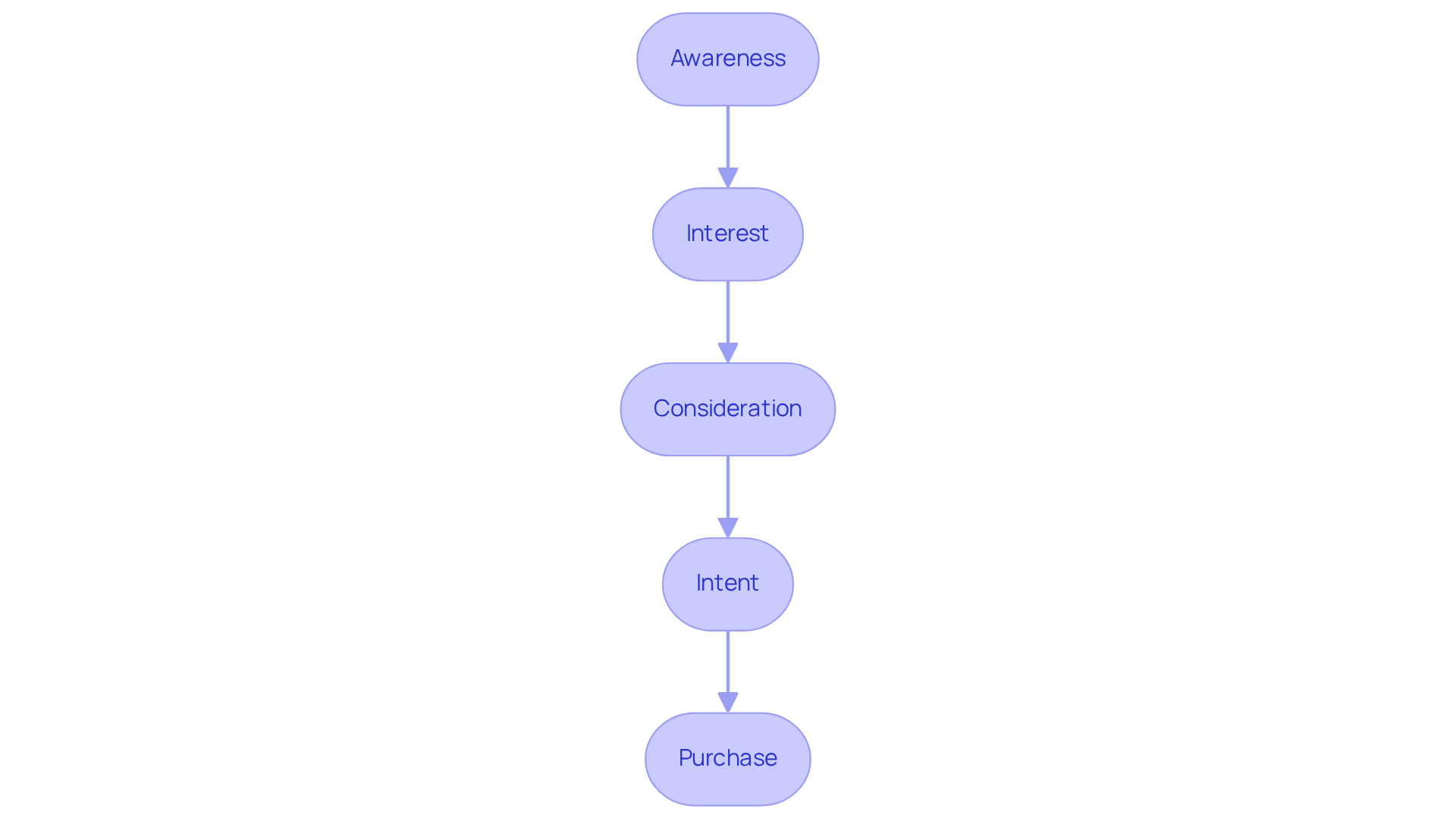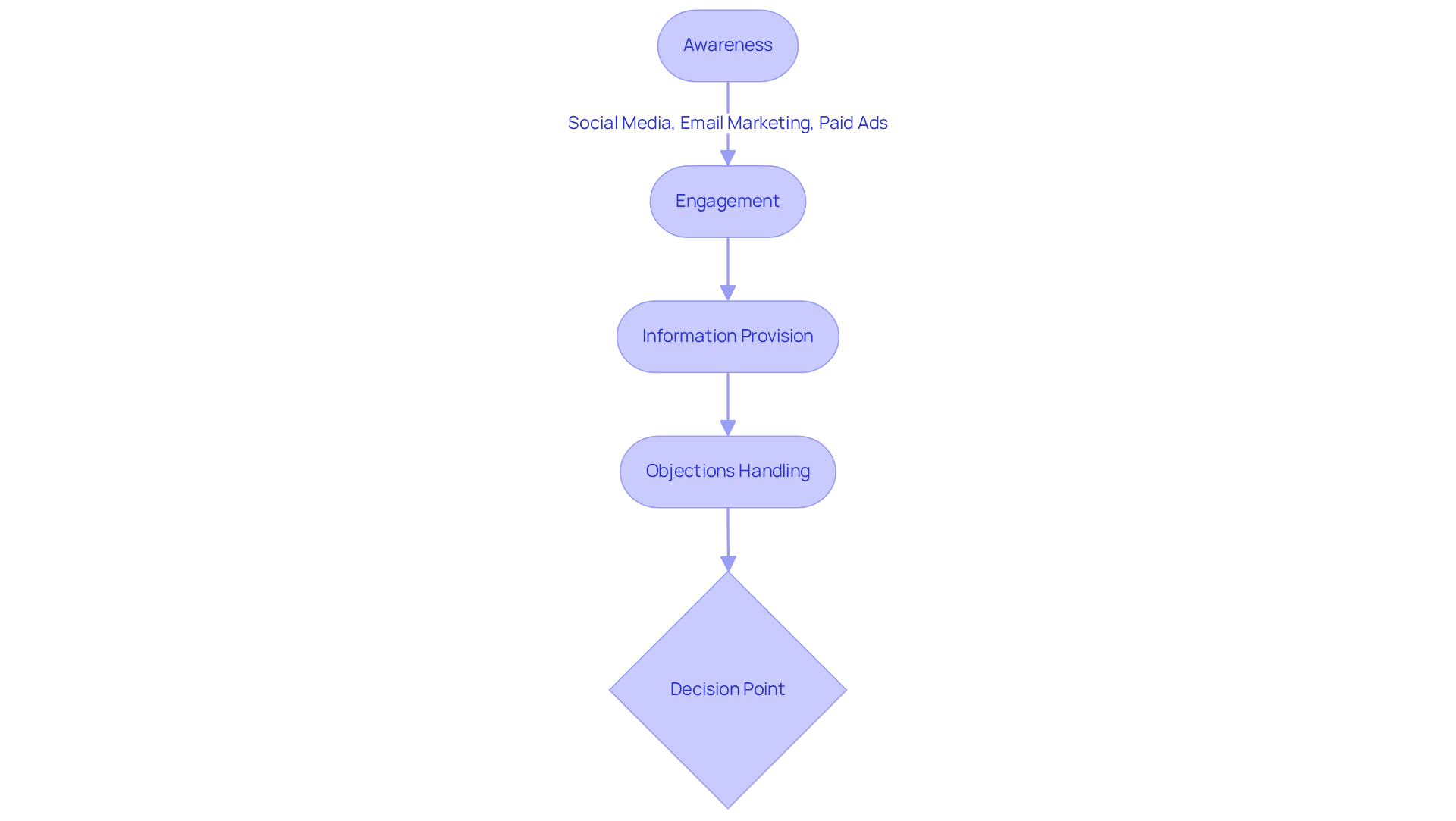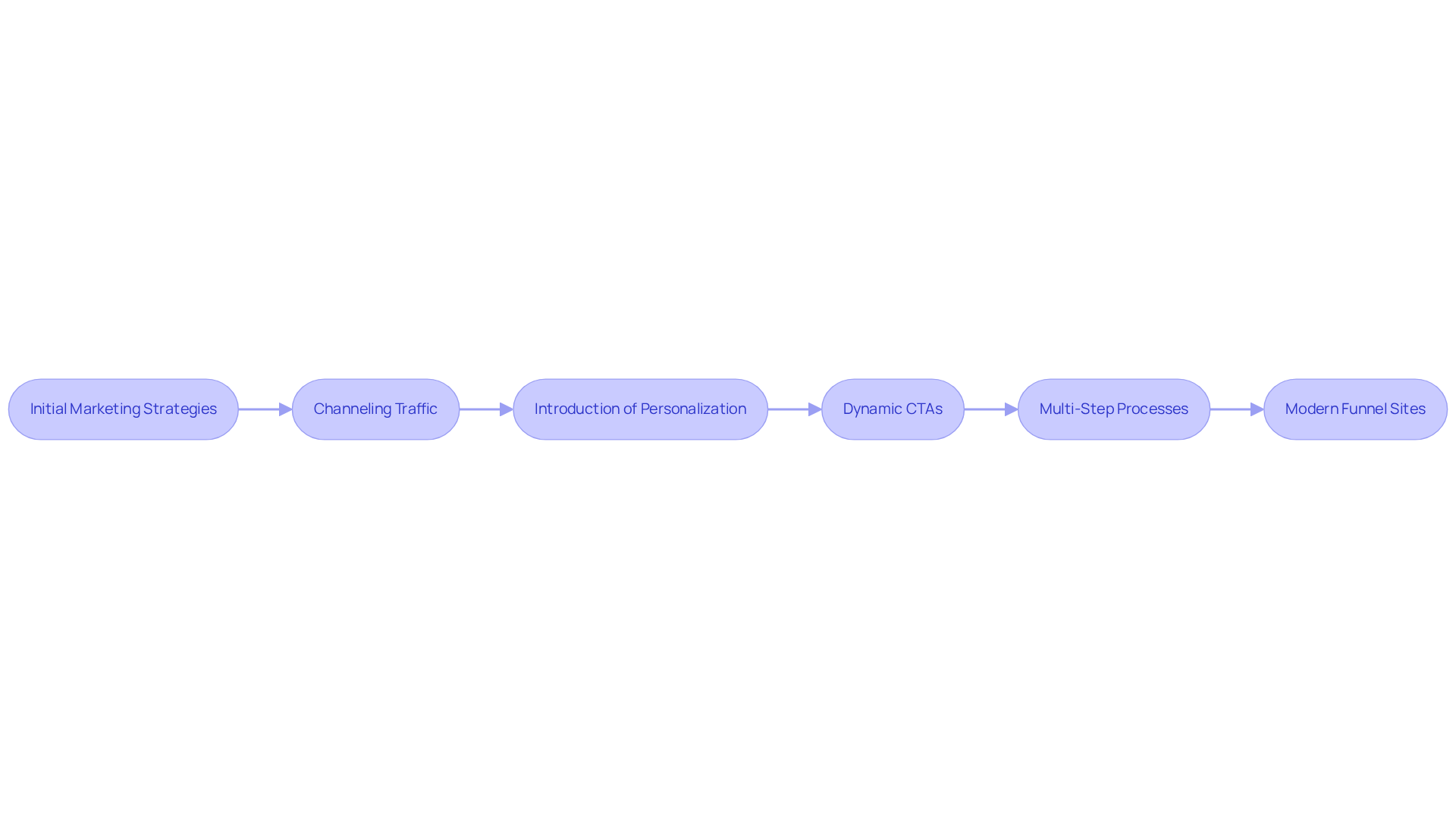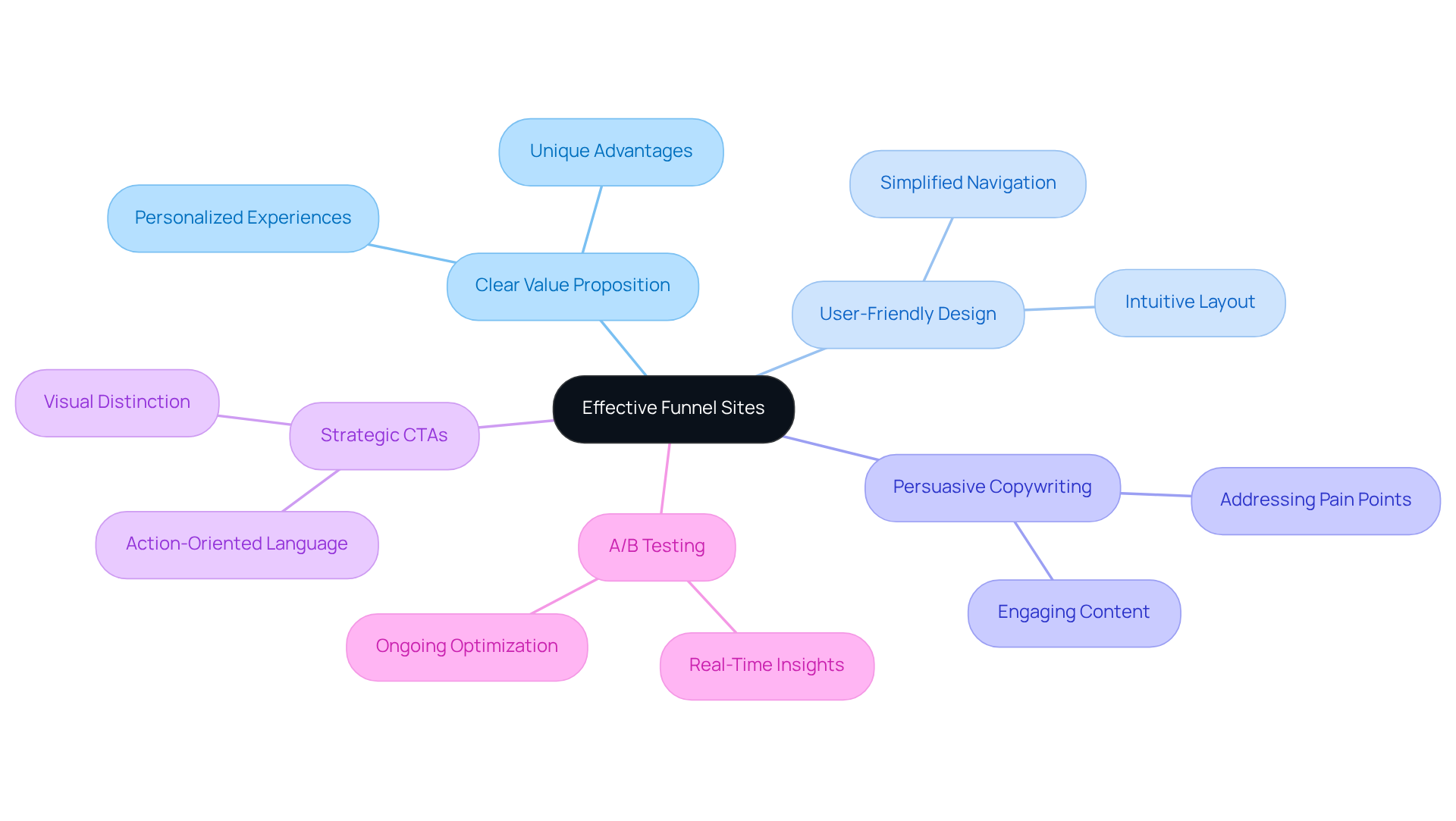
Overview
Funnel sites serve as specialized web resources meticulously crafted to guide visitors through a structured journey that culminates in a desired action, such as making a purchase or subscribing to a newsletter. Effective funnel sites are characterized by:
- Clear value propositions
- User-friendly designs
- Persuasive copywriting
- Strategic calls-to-action
- Implementation of continuous A/B testing
These elements are essential for enhancing user experience and significantly improving conversion rates. By integrating these strategies, businesses can create a compelling online presence that not only attracts visitors but also converts them into loyal customers.
Introduction
Funnel sites have emerged as indispensable tools in the digital marketing landscape, expertly guiding potential customers through a meticulously structured journey that culminates in desired actions, such as purchases or subscriptions. By leveraging persuasive design, targeted messaging, and strategic calls-to-action, these sites not only enhance user experience but also significantly boost conversion rates.
However, as competition intensifies and consumer expectations evolve, brands must ask: how can they ensure their funnel sites remain effective and engaging? This article delves into the core concepts, characteristics, and transformative role of funnel sites in direct-to-consumer marketing, offering insights into optimizing these vital resources for success.
Define Funnel Site: Core Concepts and Functionality
A funnel site serves as a specialized web resource designed to guide visitors through a structured experience, ultimately leading them to achieve a desired action, such as making a purchase or subscribing to a newsletter. This analogy illustrates the narrowing process of potential clients as they navigate through the five phases of the marketing model:
- Awareness
- Interest
- Consideration
- Intent
- Purchase
Funnel sites typically utilize persuasive design features, targeted messaging, and strategic calls-to-action (CTAs) to enhance user experience and increase success rates. By prioritizing the customer experience, pathway platforms aim to minimize friction and enhance transaction likelihood, establishing themselves as vital resources for DTC brands seeking to optimize their online sales opportunities.
In 2025, average success rates for pathway platforms in DTC marketing are projected to improve significantly, with effective pathway strategies yielding up to a 50% increase in successful outcomes. For instance, a SaaS client experienced a 45% revenue increase after refining their sales process, highlighting the potential impact of well-organized conversion sites. Similarly, a fitness app client achieved a 50% rise in conversions through personalized content and targeted follow-ups, underscoring the effectiveness of tailored strategies. As Bernard Meyer asserts, "Ultimately, the key to marketing processes is their specificity, which means offering precise solutions to clients’ precise issues." In summary, funnel sites play a crucial role in digital marketing by effectively guiding prospective clients through their purchasing journey.

Contextualize Funnel Sites in DTC Marketing Strategies
In the realm of direct-to-consumer (DTC) marketing, pathways serve as pivotal elements for enhancing client acquisition. These sites are meticulously crafted to draw in potential customers through various channels, including social media, email marketing, and paid advertising. Upon arrival, visitors encounter a thoughtfully arranged layout that guides them through the sales process. This journey is enriched by providing , addressing common objections, and ultimately steering them toward a decision point.
Incorporating funnel sites into marketing strategies empowers DTC brands to streamline the customer journey, significantly reducing drop-off rates and enhancing overall sales performance. For instance, landing pages can achieve success rates as high as 11.45% when optimized effectively, in stark contrast to the average rate of 2.35%. Furthermore, referral traffic boasts the highest success rate at 10.99%, underscoring the importance of targeted traffic sources.
Current trends indicate that DTC brands are increasingly leveraging conversion platforms to enhance their marketing efficiency. A compelling case is a $30M apparel brand that collaborated with Parah Group, which revamped their homepage to emphasize social proof and reviews, gamified the progress bar for free shipping thresholds, and introduced complimentary gifts for orders exceeding a certain cart size. These strategies culminated in a 35% increase in transformation rates and a 10% boost in revenue per visitor. Moreover, incorporating social evidence on landing pages can further bolster trust and conversion rates; pages featuring social proof exhibit an average conversion rate of 12.5%, compared to 11.4% for those lacking it, highlighting its critical importance.
As the DTC market continues to expand, projected to reach $213 billion in sales by 2024—a remarkable increase of approximately 178% since 2019—the strategic utilization of landing pages will be essential for brands aiming to attract and retain customers in a competitive landscape. Parah Group's innovative CRO strategies, as evidenced by their successful case studies, demonstrate how DTC brands can enhance their profitability through effective optimization of the customer journey.

Trace the Evolution of Funnel Sites in Marketing
The evolution of landing pages reflects significant advancements in digital marketing and shifts in consumer behavior. Initially, marketing strategies were straightforward, primarily focused on channeling traffic to a funnel site. However, as competition escalated and consumer expectations heightened, landing pages evolved to include more sophisticated features such as personalized content, dynamic calls-to-action (CTAs), and multi-step processes. The rise of data analytics has further influenced the design and functionality of landing pages, enabling marketers to craft tailored experiences that resonate with their target audience.
Today, are integral to comprehensive marketing strategies, showcasing a profound understanding of the customer journey and the importance of optimizing every interaction. At Parah Group, we leverage our expertise in Conversion Rate Optimization (CRO) to enhance these pathways, focusing on sustainable growth and profitability for direct-to-consumer (DTC) brands. Our approach ensures that every element of the process is fine-tuned not only to attract traffic but also to convert visitors into loyal customers, ultimately supporting a brand's enduring success.

Identify Key Characteristics of Effective Funnel Sites
Effective funnel sites embody several key characteristics that significantly enhance their capacity to convert visitors into customers:
- Clear Value Proposition: A compelling value proposition is essential for capturing visitor interest. It succinctly conveys the unique advantages of the product or service, clarifying why prospective clients should choose it over competitors. Research indicates that 80% of consumers are more likely to make a purchase when brands offer personalized experiences, underscoring the necessity of tailoring value propositions to meet customer needs.
- User-Friendly Design: An intuitive layout is crucial for guiding users seamlessly through the funnel. A well-organized navigation system enables users to locate what they seek swiftly, thereby increasing the likelihood of success. Studies demonstrate that can significantly reduce drop-off rates, enhancing overall user satisfaction.
- Persuasive Copywriting: Engaging and persuasive copy that addresses customer pain points and highlights solutions can profoundly influence conversion rates. Effective copywriting not only informs but also resonates with the audience, fostering a connection that encourages action.
- Strategic CTAs: Well-positioned and clearly defined calls-to-action (CTAs) are vital for motivating users to take the next step in the process, whether it’s signing up for a newsletter or completing a purchase. Effective CTAs should be action-oriented and visually distinct, guiding users toward desired actions.
- [A/B Testing](https://parahgroup.com): Ongoing testing and enhancement of process components empower brands to refine their strategy based on real-time information and user insights. Consistent A/B testing can lead to notable improvements in success rates, as minor adjustments can exert a considerable influence over time.
By integrating these characteristics, DTC brands can effectively drive conversions and cultivate long-term customer relationships through their funnel sites.

Conclusion
Funnel sites are a pivotal component in the digital marketing landscape, expertly crafted to navigate visitors through a structured journey toward specific actions, such as purchases or subscriptions. By ensuring a seamless experience, these platforms not only elevate customer engagement but also significantly enhance conversion rates for direct-to-consumer (DTC) brands.
This article underscores essential elements of funnel sites, including their fundamental functionalities, the criticality of user experience, and the strategic application of persuasive design elements. It highlights the evolution of these sites in response to shifting consumer behavior and the growing demand for personalized interactions. Successful funnel sites manifest characteristics such as:
- Clear value propositions
- User-friendly designs
- Compelling calls-to-action
All of which bolster their capacity to transform visitors into loyal customers.
As the DTC market continues to flourish, the strategic deployment of funnel sites becomes increasingly vital. Brands must prioritize the optimization of these platforms, not only to attract potential customers but also to foster enduring relationships. By adopting best practices in funnel site design and concentrating on the customer journey, DTC brands can strategically position themselves for sustained growth and enhanced profitability in a competitive landscape.
Frequently Asked Questions
What is a funnel site?
A funnel site is a specialized web resource designed to guide visitors through a structured experience that leads them to achieve a desired action, such as making a purchase or subscribing to a newsletter.
What are the five phases of the marketing model associated with funnel sites?
The five phases of the marketing model are Awareness, Interest, Consideration, Intent, and Purchase.
How do funnel sites enhance user experience?
Funnel sites enhance user experience by utilizing persuasive design features, targeted messaging, and strategic calls-to-action (CTAs) to minimize friction and increase the likelihood of transactions.
What is the projected success rate for pathway platforms in DTC marketing by 2025?
By 2025, average success rates for pathway platforms in DTC marketing are projected to improve significantly, with effective strategies yielding up to a 50% increase in successful outcomes.
Can you provide examples of successful outcomes from funnel sites?
Yes, a SaaS client experienced a 45% revenue increase after refining their sales process, while a fitness app client achieved a 50% rise in conversions through personalized content and targeted follow-ups.
What is the main goal of funnel sites in digital marketing?
The main goal of funnel sites in digital marketing is to effectively guide prospective clients through their purchasing journey, ultimately increasing the chances of conversion.
FAQs











